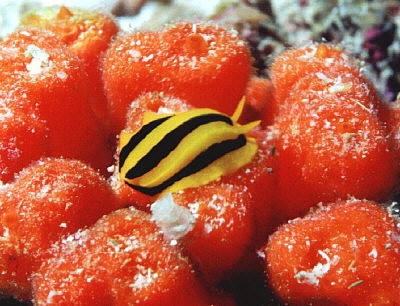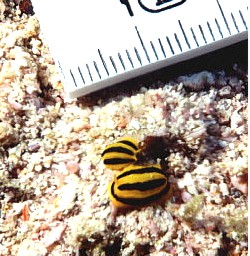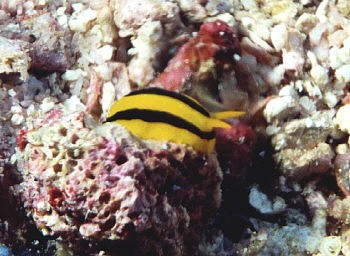
Phyllidia koehleri
Perrone, 2000
Order: NUDIBRANCHIA
Suborder: DORIDINA
Superfamily: EUDORIDOIDEA
Family: Phyllidiidae
DISTRIBUTION
Known only from the Maldives, Indian Ocean.
PHOTO
TOP RIGHT: North Male Atoll, Himmafushi Is., divesite "Rainbow Reef" 24 m, size 11 mm, Oct. 27, 1999. this one was found with the red sponge. BOTTOM RIGHT: South Male Atoll, Guraidhoo Is., divesite "Guraidhoo Kandu", 23m, size 9 mm, Oct. 24, 1999. BOTTOM LEFT: South Male Atoll, Guraidhoo Is., divesite "Guraidhoo Kandu", 21m, sizes 7, 9 mm, Oct. 24, 1999. Maldives Islands.
PHOTO: Erwin Koehler.
Until 2 March 2001 this species was called Phyllidia? sp. 1 in the Forum
See message below.
Reference:
• Perrone, A.S. (2000) A new species of Nudibranchia of the genus Phyllidia Cuvier (Gastropoda, Opisthobranchia) from the Maldive Islands. Basteria, 64: 89-97.


Rudman, W.B., 1999 (November 12) Phyllidia koehleri Perrone, 2000. [In] Sea Slug Forum. Australian Museum, Sydney. Available from http://www.seaslugforum.net/find/phylsp1
Related messages
Phyllidia koehleri? and P. ocellata on red sponge
February 20, 2009
From: Marcel Tanke

Concerning message #22020:
Dear Bill,
We found this 2 phyllidiids feeding on a red sponge. The first, large one clearly Phyllidia ocellata. The second, small one, has the same yellow / orange main color. Could it be a juvenile P. ocellata? However, the long black stripes and small radial stripes on the edge of the mantle are uncommon for P. ocellata.
Pattern wise, the closed I could come is the white / black Phyllidiopsis sphingis.
Locality: Simalan Islands, site West of Eden , 20 m, Thailand, Adaman Sea, 29 January 2009. Length: 1 cm. Photographer: Marcel Tanke.
I checked several websites and books, no success.
Do you have any suggestions?
Best regards,
Marcel
marceltanke@cs.com
Tanke, M.A., 2009 (Feb 20) Phyllidia koehleri? and P. ocellata on red sponge. [Message in] Sea Slug Forum. Australian Museum, Sydney. Available from http://www.seaslugforum.net/find/22264
Dear Marcel,
Nice to get another observation linking phyllidiids to red sponges, though I don't think encrusting or thin forms like this would be easy to identify from photos only. It does however show the danger of thinking there is no food nearby when you see slugs crawling on sand - it is often only one sand grain beneath them!
Now to identfy your phyllidiids. The large one is indeed P. ocellata and your animal is identical to a David Brunckhorst photo of one from Thailand to be found on the species Fact Sheet.
I am pretty sure the small one is a colour form of Phyllidia koehleri. Normally it has three longitudinal black bands and ridges much like a species of Phyllidiopsis. However there is a photo in a message from Erwin Koehler [message #1533] of a specimen with radiating black bands on the mantle skirt much like in your animal. Your likening it to Phyllidiopsis sphingis is quite understandable. As I commented in an earlier message [#3741] the colour pattern and thin longitudinal ridges down the body certainly are reminiscent of species of Phyllidiopsis.
Best wishes,
Bill Rudman
Phyllidia koehleri
March 2, 2001
From: Erwin Köhler

Dear Bill,
Attached is a photo of Phyllidia koehleri Perrone, 2000 from the Maldives, South-Male Atoll, Vagali Island, divesite Vagali Caves, size 15 mm, depth 16 m, Sept. 22, 2000.
Antonio S. Perrone (2000) named it in his description after me :o-))
More photos are at http://www.medslugs.de/E/Maldives/Phyllidia_koehleri.htm
Reference:
Perrone, A.S. (2000) A new species of Nudibranchia of the genus Phyllidia Cuvier (Gastropoda, Opisthobranchia) from the Maldive Islands. Basteria, 64: 89-97.
Cheers
Erwin
Medslugs.Koehler@t-online.de
Koehler, E., 2001 (Mar 2) Phyllidia koehleri. [Message in] Sea Slug Forum. Australian Museum, Sydney. Available from http://www.seaslugforum.net/find/3741Congratulations Erwin,
This is the one I have been calling Phyllidia? sp. 1. It certainly has similarities to the Phyllidiopsis striata group externally. I see from Perrone's paper that all the colour forms I have on this page are considered to be a single species.
Best wishes
Bill Rudman
Re: Phyllidia? sp. 1
January 21, 2000
From: Erwin Koehler

Hi Bill,
a Happy New Year to you!
At Wolfgang Seifarth's site is a photo labelled Reticulidia sp. from the Maldives, Ellaidhoo Island, which looks exactly like my Phyllidia sp. 1. Wolfgang says the ID Reticulidia sp. was made a long time ago by Bill Rudman...so what is it?
I attach a smaller version of the photo.
PHOTO: Wolfgang Seifarth.
Erwin.
Medslugs.Koehler@t-online.de
Koehler, E., 2000 (Jan 21) Re: Phyllidia? sp. 1. [Message in] Sea Slug Forum. Australian Museum, Sydney. Available from http://www.seaslugforum.net/find/1763Dear Erwin,
I don't remember identifying the animal as Reticulidia for Wolfgang but I must have based my guess on the ridges on its back. Identifying unknowns from photographs is a very perilous occupation. Without specimens there is no way to be sure, but my feeling now is that it is not Reticulidia but probably closely related to Phyllidia polkadotsa, which is also yellow with back markings and has an identical ridge down each side of the mantle.
Best wishes,
Bill Rudman.
Another yellow phyllidiid from Maldives?
November 16, 1999
From: Erwin Koehler

Dear Bill,
Here is one from the Maldives, Embudu Is., divesite Embudu Out, depth 17m, size 11 mm, date Oct. 23, 1999.
Erwin
ps. The problems with my camera are located: The new port of the housing was not o.k.
Medslugs.Koehler@t-online.de
Koehler, E., 1999 (Nov 16) Another yellow phyllidiid from Maldives?. [Message in] Sea Slug Forum. Australian Museum, Sydney. Available from http://www.seaslugforum.net/find/1533Dear Erwin,
Either the Maldives have become a centre for yellow phyllidiids or else this is a colour form of your earlier photos. Interestingly some of the black marks in this photo seem to be lines breaking up into spots. One possibility is that Phyllidia polkadotsa ranges in colour form from spots to black lines.
It is an interesting puzzle.
Bill Rudman.
Rudman, W.B., 1999 (Nov 16). Comment on Another yellow phyllidiid from Maldives? by Erwin Koehler. [Message in] Sea Slug Forum. Australian Museum, Sydney. Available from http://www.seaslugforum.net/find/1533A new phyllidiid from the Maldives
November 13, 1999
From: Erwin Koehler

Hi Bill,
Here is the first "unknown" from my recent Maldives trip:
TOP RIGHT: North Male Atoll, Himmafushi Is., divesite "Rainbow Reef" 24 m, size 11 mm, date Oct. 27, 1999. This one was found with the red sponge.
BOTTOM RIGHT: South Male Atoll, Guraidhoo Is., divesite "Guraidhoo Kandu", 23m, size 9 mm, date Oct. 24, 1999
BOTTOM LEFT: South Male Atoll, Guraidhoo Is., divesite "Guraidhoo Kandu", 21m, sizes 7 + 9 mm, date Oct. 24, 1999. three specimens at one dive!
Please excuse the poor quality - I had again troubles with my camera: all photos are excellent sharp - except the part in the center of the photos.
Erwin
Medslugs.Koehler@t-online.de


Dear Erwin,
This looks a very interresting find. If it wasn't bright yellow I would say that it was one of the striped species of Phyllidiopsis such as P. striata or P. phiphiensis. It also has similarities in shape and colour to Phyllidia polkadotsa but that has black spots not lines. In fact the sharp ridge down either side of the mantle look just like those in P. polkadotsa.
I suspect that this is a new species. You also seem to have found its food. Altogether a good days work!
Best wishes,
Bill Rudman.
